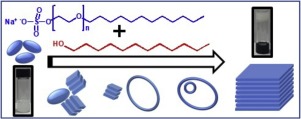当前位置:
X-MOL 学术
›
Colloids Surf. A Physicochem. Eng. Aspects
›
论文详情
Our official English website, www.x-mol.net, welcomes your
feedback! (Note: you will need to create a separate account there.)
Effect of ethoxylation and lauryl alcohol on the self-assembly of sodium laurylsulfate: Significant structural and rheological transformation
Colloids and Surfaces A: Physicochemical and Engineering Aspects ( IF 4.9 ) Pub Date : 2020-06-01 , DOI: 10.1016/j.colsurfa.2020.124704 Chandra Ade-Browne , Marzieh Mirzamani , Arnab Dawn , Shuo Qian , Ryan G. Thompson , Robert W. Glenn , Harshita Kumari
Colloids and Surfaces A: Physicochemical and Engineering Aspects ( IF 4.9 ) Pub Date : 2020-06-01 , DOI: 10.1016/j.colsurfa.2020.124704 Chandra Ade-Browne , Marzieh Mirzamani , Arnab Dawn , Shuo Qian , Ryan G. Thompson , Robert W. Glenn , Harshita Kumari

|
Abstract Fatty alcohols are added to the surfactant solutions to modify foaming and lubrication properties, while the degree of ethoxylation is increased to improve mildness to the skin. However, it is envisioned that both parameters are capable of manipulating rheological and morphological properties. Therefore, an efficient control over the carbon chain length, amount of fatty alcohol and degree of ethoxylation could modify the surfactant self-assembly in an unprecedented way. The present work is focused on understanding the structural transformation, intermolecular interactions and rheological properties of the colloidal systems containing various amounts of lauryl alcohol (LA), and surfactant with varying degrees of ethoxylation. Combined small-angle neutron scattering (SANS), nuclear magnetic resonance (NMR) spectroscopy, rheological and morphological studies were performed to elucidate these properties. The results reveal that an increase in LA content increases the system viscosity ultimately forming a gel, and drives the assembly pattern of the surfactant from ellipsoidal micellar to lamellar via a vesicular and vesicular/lamellar mixed intermediates. On the other hand, higher degrees of ethoxylation delay the onset of morphological transformation and gel formation. The interplay between hydrophobic and polar interactions coupled with hydrogen bonding interactions drive the overall rheological and morphological transformations. Therefore, fine-tuning residual chemicals can offer a novel tool for optimization of the product formulation.
中文翻译:

乙氧基化和月桂醇对十二烷基硫酸钠自组装的影响:显着的结构和流变转变
摘要 在表面活性剂溶液中加入脂肪醇以改善起泡和润滑性能,同时增加乙氧基化程度以改善对皮肤的温和性。然而,设想这两个参数都能够操纵流变学和形态学特性。因此,对碳链长度、脂肪醇的量和乙氧基化程度的有效控制可以以前所未有的方式改变表面活性剂的自组装。目前的工作重点是了解含有不同量月桂醇 (LA) 和具有不同乙氧基化程度的表面活性剂的胶体系统的结构转变、分子间相互作用和流变特性。组合小角中子散射 (SANS)、核磁共振 (NMR) 光谱、进行了流变学和形态学研究以阐明这些特性。结果表明,LA 含量的增加会增加系统粘度,最终形成凝胶,并通过囊泡和囊泡/层状混合中间体驱动表面活性剂从椭圆形胶束到层状的组装模式。另一方面,较高程度的乙氧基化延迟了形态转变和凝胶形成的开始。疏水和极性相互作用以及氢键相互作用之间的相互作用推动了整体流变学和形态学转变。因此,微调残留化学品可以提供一种优化产品配方的新工具。结果表明,LA 含量的增加会增加系统粘度,最终形成凝胶,并通过囊泡和囊泡/层状混合中间体驱动表面活性剂从椭圆形胶束到层状的组装模式。另一方面,较高程度的乙氧基化延迟了形态转变和凝胶形成的开始。疏水和极性相互作用以及氢键相互作用之间的相互作用推动了整体流变学和形态学转变。因此,微调残留化学品可以提供一种优化产品配方的新工具。结果表明,LA 含量的增加会增加系统粘度,最终形成凝胶,并通过囊泡和囊泡/层状混合中间体驱动表面活性剂从椭圆形胶束到层状的组装模式。另一方面,较高程度的乙氧基化延迟了形态转变和凝胶形成的开始。疏水和极性相互作用以及氢键相互作用之间的相互作用推动了整体流变学和形态学转变。因此,微调残留化学品可以提供一种优化产品配方的新工具。更高程度的乙氧基化延迟了形态转变和凝胶形成的开始。疏水和极性相互作用以及氢键相互作用之间的相互作用推动了整体流变学和形态学转变。因此,微调残留化学品可以提供一种优化产品配方的新工具。更高程度的乙氧基化延迟了形态转变和凝胶形成的开始。疏水和极性相互作用以及氢键相互作用之间的相互作用推动了整体流变学和形态学转变。因此,微调残留化学品可以提供一种优化产品配方的新工具。
更新日期:2020-06-01
中文翻译:

乙氧基化和月桂醇对十二烷基硫酸钠自组装的影响:显着的结构和流变转变
摘要 在表面活性剂溶液中加入脂肪醇以改善起泡和润滑性能,同时增加乙氧基化程度以改善对皮肤的温和性。然而,设想这两个参数都能够操纵流变学和形态学特性。因此,对碳链长度、脂肪醇的量和乙氧基化程度的有效控制可以以前所未有的方式改变表面活性剂的自组装。目前的工作重点是了解含有不同量月桂醇 (LA) 和具有不同乙氧基化程度的表面活性剂的胶体系统的结构转变、分子间相互作用和流变特性。组合小角中子散射 (SANS)、核磁共振 (NMR) 光谱、进行了流变学和形态学研究以阐明这些特性。结果表明,LA 含量的增加会增加系统粘度,最终形成凝胶,并通过囊泡和囊泡/层状混合中间体驱动表面活性剂从椭圆形胶束到层状的组装模式。另一方面,较高程度的乙氧基化延迟了形态转变和凝胶形成的开始。疏水和极性相互作用以及氢键相互作用之间的相互作用推动了整体流变学和形态学转变。因此,微调残留化学品可以提供一种优化产品配方的新工具。结果表明,LA 含量的增加会增加系统粘度,最终形成凝胶,并通过囊泡和囊泡/层状混合中间体驱动表面活性剂从椭圆形胶束到层状的组装模式。另一方面,较高程度的乙氧基化延迟了形态转变和凝胶形成的开始。疏水和极性相互作用以及氢键相互作用之间的相互作用推动了整体流变学和形态学转变。因此,微调残留化学品可以提供一种优化产品配方的新工具。结果表明,LA 含量的增加会增加系统粘度,最终形成凝胶,并通过囊泡和囊泡/层状混合中间体驱动表面活性剂从椭圆形胶束到层状的组装模式。另一方面,较高程度的乙氧基化延迟了形态转变和凝胶形成的开始。疏水和极性相互作用以及氢键相互作用之间的相互作用推动了整体流变学和形态学转变。因此,微调残留化学品可以提供一种优化产品配方的新工具。更高程度的乙氧基化延迟了形态转变和凝胶形成的开始。疏水和极性相互作用以及氢键相互作用之间的相互作用推动了整体流变学和形态学转变。因此,微调残留化学品可以提供一种优化产品配方的新工具。更高程度的乙氧基化延迟了形态转变和凝胶形成的开始。疏水和极性相互作用以及氢键相互作用之间的相互作用推动了整体流变学和形态学转变。因此,微调残留化学品可以提供一种优化产品配方的新工具。











































 京公网安备 11010802027423号
京公网安备 11010802027423号